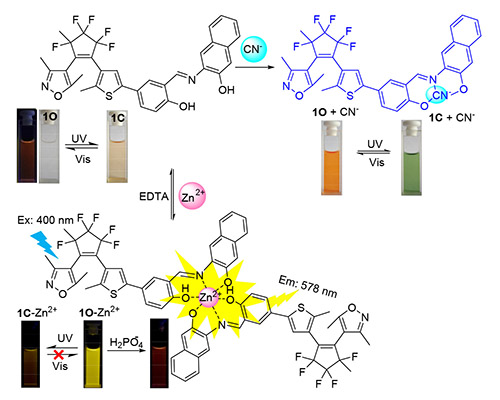| [1] (a) Williams, R. J. P. The Biological Chemistry of the Elements, Clarendon, Oxford, 1991, p. 174.
(b) Bianchi, A.; Bowman-James, K.; García-España, E. Supramolecular Chemistry of Anions, Wiley-VCH, New York, 1997.
(c) Vazquez, M.; Fabrizzi, L.; Taglietti, A.; Pedrido, R. M.; Gonzalez-Noya, A. M.; Bermejo, M. R. Angew. Chem., Int. Ed. 2004, 43, 1962.
[2] (a) Silva, J.-J R. F. D.; Williams, R. J. P. The Biological Chemistry of the Elements:the Inorganic Chemistry of Life, Oxford University Press, Oxford, 2001, p. 315.
(b) Vallee, B. L.; Auld, D. S. Acc. Chem. Res. 1993, 26, 543.
(c) Bush, I.; Pettingell, W. H.; Multhaup, G.; Paradis, M. D.; Vonsattel, J. P.; Gusella, J. F.; Beyreuther, K.; Masters, C. L.; Tanzi, R. E. Science 1994, 265, 1464.
(d) Fraker, P. J.; King, L. E. Annu. Rev. Nutr. 2004, 24, 277.
(e) Cuajungco, M. P.; Lees, G. J. Neurobiol. Dis. 1997, 4, 137.
(f) Frassinetti, S.; Bronzetti, G. L.; Caltavuturo, L.; Cini, M. Della Croce, C. J. Environ. Pathol. Toxicol. Oncol. 2006, 25, 597.
[3] (a) Lai, J.; Moxey, A.; Nowak, G.; Vashum, K.; Bailey, K.; McEvoy, M. J. Affective Disord. 2012, 136, 31.
(b) Weiss, J. H.; Sensi, S. L.; Koh, J. Y. Trends Pharmacol. Sci. 2000, 21, 395.
(c) Maes, M.; Vos, N. D.; Demedts, P.; Wauters, A.; Neels, H. J. Affective Disord. 1999, 56, 189.
[4] Carol, P.; Sreejith, S.; Ajayaghosh, A. Chem. Asian. J. 2007, 2, 338.
[5] (a) Zhang, J. F.; Bhuniya, S. Y.; Lee, H.; Bae, C.; Lee, J. H.; Kim, J. S. Tetrahedron Lett. 2010, 51, 3719.
(b) Voegelin, A.; Pfister, S.; Scheinost, A. C.; Marcus, M. A.; Kretzschmar, R. Environ. Sci. Technol. 2005, 39, 6616.
(c) Callender, E.; Rice, K. C. Environ. Sci. Technol. 2000, 34, 232.
(d) Li, L.; Dang, Y. Q.; Li, H. W.; Wang, B.; Wu, Y. Tetrahedron Lett. 2010, 51, 618.
[6] (a) Tang, L.; Zhou, P.; Zhong, K.; Hou, S. Sens. Actuators, B:2013, 182, 439.
(b) Kumari, N.; Jha, S.; Bhattacharya, S. J. Org. Chem. 2011, 76, 8215.
(c) Zhang, W.; Xu, K.; Yue, L.; Shao, Z.; Feng, Y.; Fang, M. Dyes Pigm. 2017, 137, 560.
(d) Shan, Y.; Wu, Q.; Sun, N.; Sun, Y.; Cao, D.; Liu, Z. Macromol. Chem. Phys. 2017, 186, 295.
(e) Liu, T.; Huo, F.; Li, J.; Cheng, F.; Ying, C. Sens. Actuators, B 2017, 239, 526.
[7] (a) Hachiya, H.; Ito, S.; Fushinuki, Y.; Masadome, T.; Asano, Y.; Imato, T. Talanta 1999, 48, 997.
(b) Wang, L. Y.; Li, L. Q.; Cao, D. R. Sens. Actuator, B 2017, 239, 1307.
(c) Kalpana, P.; Suganya, S.; Velmathi, S. Spectrochim. Acta, A 2017, 171, 162.
(d) Li, H.; Zhao, P.; Zou, N.; Wang, H.; Sun, K. Tetrahedron Lett. 2017, 58, 30.
[8] Saenger, W. Principles of Nucleic Acid Structure, Springer, New York, 1988.
[9] (a) Paredes, J. M.; Giron, M. D.; Ruedas-Rama, M. J.; Orte, A.; Crovetto, L.; Talavera, E. M.; Salto, R.; Alvarez-Pez, J. M. J. Phys. Chem. B 2013, 117, 8143.
(b) Bhaumik, C.; Das, S.; Maity, D.; Baitalik, S. Dalton Trans. 2011, 40, 11795.
[10] (a) Irie, M. Chem. Rev. 2000, 100, 1685.
(b) Tian, H.; Yang, S. Chem. Soc. Rev. 2004, 35, 85.
(c) Irie, M.; Fukaminato, T.; Sasaki, T. Nature 2002, 420, 759.
(d) Fu, Y. L.; Fan, C. B.; Liu, G.; Pu, S. Z. Sens. Actuators, B 2017, 239, 295.
(e) Zhang, X.-X.; Wang, R. J.; Fan, C. B.; Liu, G.; Pu, S. Z. Dyes Pigm. 2017, 139, 208.
[11] (a) Wang, R. J.; Wang, N. S.; Pu, S. Z.; Zhang, X.-X.; Liu, G.; Dai, Y. F. Dyes Pigm. 2017, 146, 445.
(b) Wang, R. J.; Wang, N. S.; Tu, Y.-Y.; Liu, G.; Pu, S. Z. J. Photochem. Photobiol. A 2018, 364, 32.
(c) Wang, R. J.; Diao, L.; Ren, Q. W.; Liu, G.; Pu, S. Z. ACS Omega 2019, 4, 309.
[12] Irie, M.; Fukaminato, T.; Matsuda, K.; Kobatake, S. Chem. Rev. 2014, 114, 12174.
[13] Wu, J. S.; Liu, W. M.; Zhuang, X. Q. Org. Lett. 2007, 9, 33.
[14] Wang, H.; Wang, B.; Shi, Z. Biosens. Bioelectron. 2015, 65, 91.
[15] (a) Dong, W. K.; Li, X. L.; Wang, L.; Zhang, Y.; Ding, Y. J. Sens. Actuators, B 2016, 229, 370.
(b) Feng, E. T.; Tu, Y.-Y.; Fan, C. B.; Liu, G.; Pu, S. Z. RSC Adv. 2017, 7, 50188.
[16] Yao, K.; Fu, J. X.; Chang, Y. X.; Li, B.; Yang, L.; Xu, K. X. Spectrochim. Acta, Part A 2018, 205, 410.
[17] Sabyasachi, T.; Sudipta, D.; Milan, G.; Mahuya, B.; Kumar, H. S.; Pratim, M. P.; Debasis, D. Spectrochim. Acta, Part A 2019, 209, 170.
[18] Purkait, R.; Chattopadhyay, D. A.; Sinha, C. Spectrochim. Acta, Part A 2019, 207, 164.
[19] Karar, M.; Paul, S.; Biswas, B. Dalton. Trans. 2018, 276, 560.
[20] Cui, S. Q.; Pu, S. Z.; Liu, G. Spectrochim. Acta, Part A 2014, 132, 339. |
